The history buff in me has a fascination with how life was lived in times gone by. We’ve constructed three coops since moving here, one large permanent coop, and two portables. We designed and constructed all three ourselves, for cost effectiveness, quality and durability of construction, and because it gave us the ability to customize our coops to our needs.
The most challenging part was coop design, and finding the right inspiration to help us set pen to paper (or mouse to pixel as was often the case). It takes some thought when planning and designing a coop, to ensure you don’t end up with something that looks like this…
Poultry rearing became explosively popular in 19th Century America, and browsing through the old poultry journals of the day, there is a wealth of inspiration and design ideas locked away in their pages, ranging from fanciful poultry palaces, to practical portables, so we thought we’d share a few of our favorites.
Fanciful Poultry Palaces
These hen houses fall squarely in to the ‘money is no object’ category of coop design and construction…
Cupolas, replete with rooster weather-vanes, were clearly popular in the mid-1800s, as shown on the following two coops.
This coop could house a small village!
Well Appointed Abodes
A coop design with divided yard for rearing multiple breeds.
These smaller, but still commodious coops are somewhat more practical for the cottage farmer.
A number of octagonal hen house designs were found amidst the pages of these old journals.
Although these simpler shed-style poultry houses were no doubt simpler to construct.
Even more practical and affordable designs of the day, better suited to smaller flocks, this model was constructed of iron, making it a hefty humble hennery!
This wooden model however would be simpler to construct today.
A-Frame model suited to areas with heavy snowfalls in winter.
This practical and economical garden coop could be simply constructed from reclaimed materials today.
Two small classic design ideas suitable for today’s garden flocks.
Practical Portables
For poultry that’s perpetually on the move, some creative portable designs included the Potter Brother’s Vermin Proof Folding Coop and Trap, designed with a rat trap built into the base of the rear wall. Ingenious.
The side walls simply unlatch and fold inwards, and the entire coop can then be folded, and relocated to another part of the farm or garden.
These more simply constructed coops are a little closer in style to some of the popular ark-like coops we still see used today.
My personal favorite though has to be this coop…and with the horse to help move it, there’s no heavy lifting!
Or perhaps this quaint French country design?
A corrugated metal option, with wheels.
This wheeled model is very spacious, but still portable.
Coops on the Cheap
A small wooden shelter with folding doors.
Of course, on the 19th Century small-holding, the farmer would often find materials around the barnyard that could be adapted for poultry housing.
19th Century farms often had spare empty flour barrels lying around, which inspired a number of small coop designs, although closing this model up at night seems tricky…
No doubt these single-door models were much more practical.
As the variety in these designs illustrate, if you’re considering constructing your own coop, providing the structure is predator and vermin proof, you’re really only limited by your imagination. We hope we’ve given you a little inspiration for building your own!

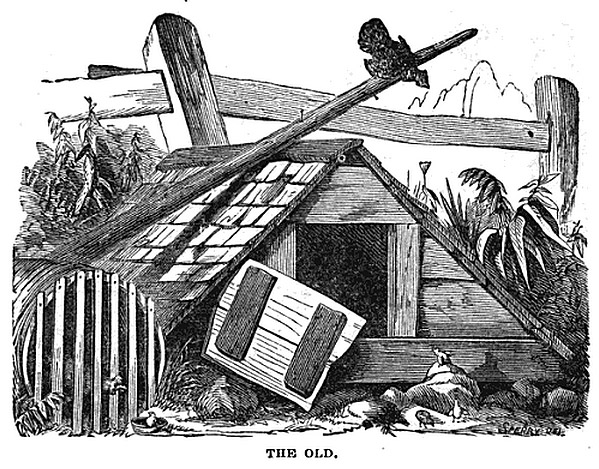
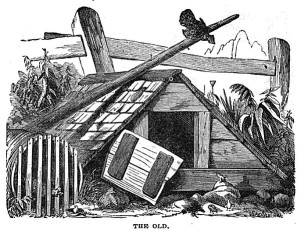
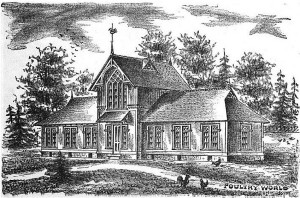


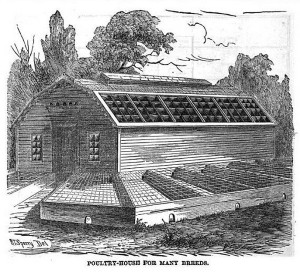
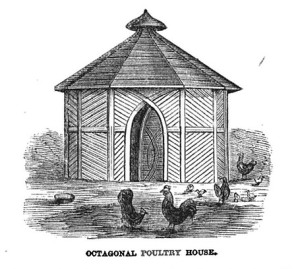

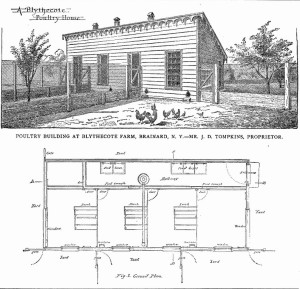
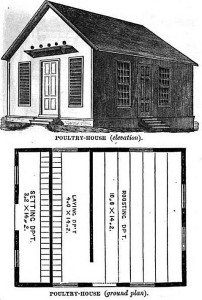
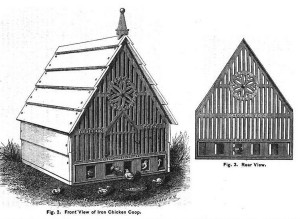
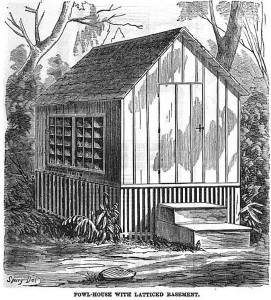
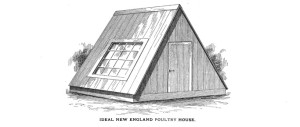
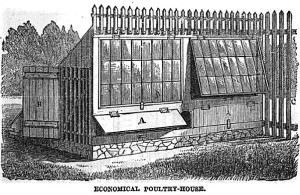
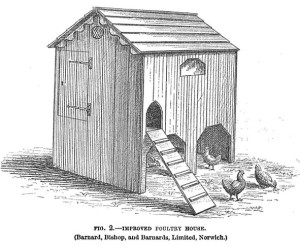
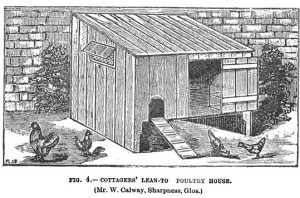
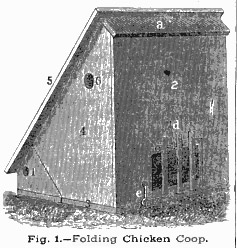
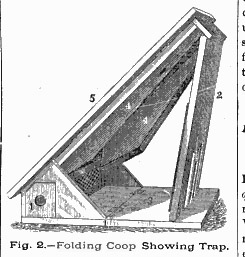

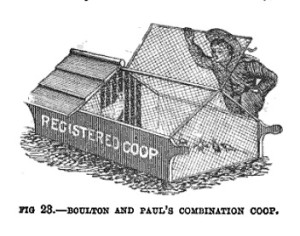

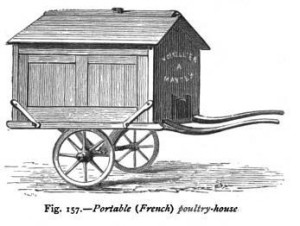

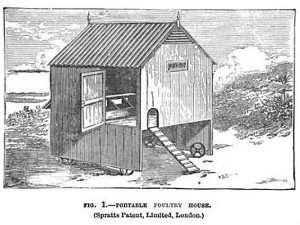
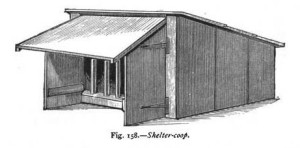

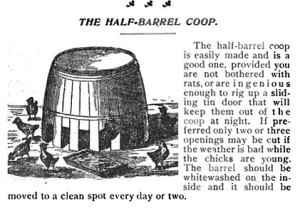

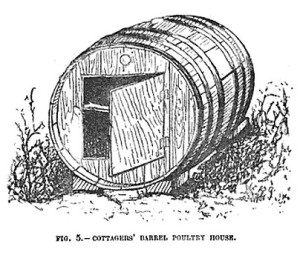







I love all these illustrations, Clare. Do you think if I show them to my husband, he might build me the smallest and simplest one? 😉
Maybe if you ask nicely he will. Although I’d show him the last one, not the first one 😉
LOL. Wow, some of those hens lived better than most humans, I think. Your first photo, labeled “the old,” looks pretty similar to sights ’round this county, even today, where chickens can be seen roaming yards and wandering down the streets. These folks would scoff to see hens puttin’ on such airs in those chicken mansions!
I’ve seen a couple near here that more closely approximate the first one too, although none of them were in active use. You couldn’t help but wonder who used to reside in them though, and how long ago!
I loved this post! I have a passion for pictures of coops and saw a bunch in this post I had never seen before. How fun.
We looked at some chicken coop books when we were planning our first coop, and honestly, most of the modern books just repeat each other, and are relatively dull and utilitarian. I had much more fun looking at some of these illustrations instead!
Inspired by this beautiful post, indeed, and have often thought how delightful to gather fresh eggs for my breakfast! My chickens (kids), however, were housed in less ‘Fanciful Poultry Palaces’ as your first pic 🙂 So enjoy visiting, dear Clare. You wealth of information amazes me!
I think if we had the first poultry palace, we’d move in there, and the chickens could have our house! 😛
What do you think of the size of the wine barrel coop? Is it too puny to be practical?
I think flour barrels might have been a little larger, with straighter sides than our modern wood wine barrels. That said though, I have two large French oak barrels here from a local winery, and looking at those, if you used the last barrel design, where it’s horizontal with a single door, I think it could be used for bantam fowl at least, as a night shelter. It would need a roost pole installed inside, and a shelf, or a way to hang a small feeder/waterer, but I think a creative crafty person could come up with something. The tricky part would be the nest box.
I imagine the iron one goes back to Victorian days when prefabricated wrought iron was freely available. In our small towns the old houses have ‘broekie’ lace on the verandahs. Modern renovations, on the cheap, use plastic. Which just looks NASTY.
I think you’re right Diana, wrought iron was very plentiful in the mid-late 1800’s, and it’s an interesting use for it. I just can’t imagine how heavy it would be to move even that small coop though!
Fabulous post Clare! I love the old illustrations and your play on words with the titles. Always an inspiration to visit you.
The architect in me loves this post immensely. The home owner in me wants to move into some of these coops. I would even support gentrification and displace the little fowl. They can move into the barrel at the bottom of your post. Ha ha.
Maybe a dumb question, but why did they need to move them on wheels? Was it for cleaner coops or better food source or am I off base here.
Good question Donna. If, unlike us, you have lots of flat ground for your hens to free-range on, you could move them from field to field throughout the year. It’s good for the land (as chickens in a concentrated area can quickly strip the soil). Moving them around also decreases parasite build-up in the soil, gives them access to fresh forage, and stops concentrated manure build-up too, although some is good to help with soil fertility. With a coop on wheels it makes transporting them easier. Farmer’s would (and still do) range chickens out on their crop fields after a harvest so they can pick through the leftovers, which for a farmer decreases the amount of supplemental feed necessary. A coop on wheels just gives the hens a secure area to roost at night, and a place to lay eggs during the day without having to herd them back to a permanent shelter each night. Because of our slopes though, our portable coops don’t have wheels, or they’d end up in the creek! 😛
Clare, Some of these houses are fantastic…I even like the first one! I stumbled upon the novel, “The Egg and I” when I was supposed to be shelving books way back in college! It’s very dated and not at all PC, but it made me laugh out loud when she described the love and tender care the chicks received ahead of her! I recall they built their houses on movable skids. Not sure why? gail
That’s funny Gail, last weekend we just watched the 1947 movie, ‘The Egg and I’, starring Claudette Colbert, Fred MacMurray. I wonder if it’s based on the same book? The skids would have had the same use as the wheels on some of these portables I expect. You just probably wouldn’t be moving them as far each time, just sliding them over a few feet. A common portable design today, with an open bottom (called a chicken tractor), is used so the chickens can free range, but they’re inside the tractor for protection from hawks and other predators. You can drag the portable pen around multiple times throughout the day to fresh areas of forage. We’ve been doing that with Frodo recently since our Bobcat attack, and a recent Cooper’s hawk attack on my neighbor’s hens. No end of fun out here in the woods 😉
Dear Clare, As you may well imagine, I have simply loved this historical posting. Once upon a time I had a chicken rearing dream in which I should keep glamorous Black Rock chickens and fresh eggs, warm from the nest would be mine each day for breakfast. Of course, this never happened in reality, but if I had seen the ‘Poultry Palace’ designs…..well who knows!!!
Aren’t those designs gorgeous? I’m not sure about chickens living in better accommodations than me. If you ever decide to build one though, maybe I’ll volunteer to become your head chicken-keeper 😉
These reproductions are a delight to look at and ponder. I’ve learned so much about designing coops from talking to friends with chickens, and from the Garden Conservancy seminar I attended; especially regarding predators.
(Thanks for stopping by to let me know about S. leucantha self-sowing – only wish I were close by to adopt some of the little guys.
I do rather love bantam fowl. But who am I kidding? I’ve got a yard the size of a postage stamp, and a poor excuse for a fence.
Really, I’m dreaming of miniature fiber-goats, more than chickens. Mini-goats only get into small amounts of mischief, right?
Thanks for answering my comment. There are many good reasons to move the chickens that you listed. So funny your chickens would end up in the creek… ha ha. I liked that the farmers would range the chickens. It would be like a treat for them getting to eat the fields leftovers, plus have new territory to roam and scratch up.
I enjoyed reading about the history of the chicken coop. A garden I admire has a beautiful old-fashioned one and designer tiny black chickens to go with it. I secretly covet those chickens, but I was traumatized by fox-related chicken deaths as a child. would love to see your coops. Carolyn
Hi Carolyn,
Here are some links to the permanent coop, but nothing like the chicken mansions above 😉
https://curbstonevalley.com/blog/?p=1267
This is the run extension we added:
https://curbstonevalley.com/blog/?p=2439
One of our portable arks (designed to sit over a fallow raised garden bed). Just scroll past Roo’s story at the top:
https://curbstonevalley.com/blog/?p=2029
and some more finish details here:
https://curbstonevalley.com/blog/?p=2086
I haven’t posted Frodo’s new ark yet, I still haven’t painted the outside 😉 Coming soon…
I would absolutely love to know the source for these wonderful illustrations. There is a chateau in France, Champs de Bataille which has fabulous bird houses like the most elaborate here – not alas, for chickens though
I’ve seen many a coop that resembled the first photo myself! A neighbor in KY let her chickens roost and nest in an old ramshackle wooden outbuilding. Poor things, they were no match for the foxes. Speaking of varmints, I hope the bobcats haven’t been causing trouble again!
Another phenomenal post!!! I loved this! I’m getting to the “sincere dreaming” phase of getting my own birds and this actually really helps a lot. Many good ideas there, time-tested. Will be referring to this post often. Thank you!! Bonnie
Wow, what a variety of hen houses! The third photo would be my dream garden shed. And now I don’t think your hens are quite as pampered as I had imagined, compared to some.
Really great post! I love those pics…
Ooh, I like the one that looks like it could be made from reclaimed materials today. What an inspirational jaunt through the past, Clare. I can’t wait until poultry raising here gets to be so popular that it inspires a brand new round of fantasy fowl architecture. Surely it’s only a matter of time. 😉
Wow, it paid to be a chicken in the late 19th century. I totally overbuilt my coop and now it sits empty until I figure out how to keep those wily raccoons out. Great post, as always.
The variety, scale and scope of designs–precious! Thanks for the chuckles and enlightenment.
What an awesome post! I stumbled onto your site because of your profile photo!..I just started blogging and chicken farming….I’m glad I found your site 🙂
Clare, the Fanciful Poultry Palaces made me laugh out loud. I was particularly charmed by the cupolas with the rooster weather vanes!